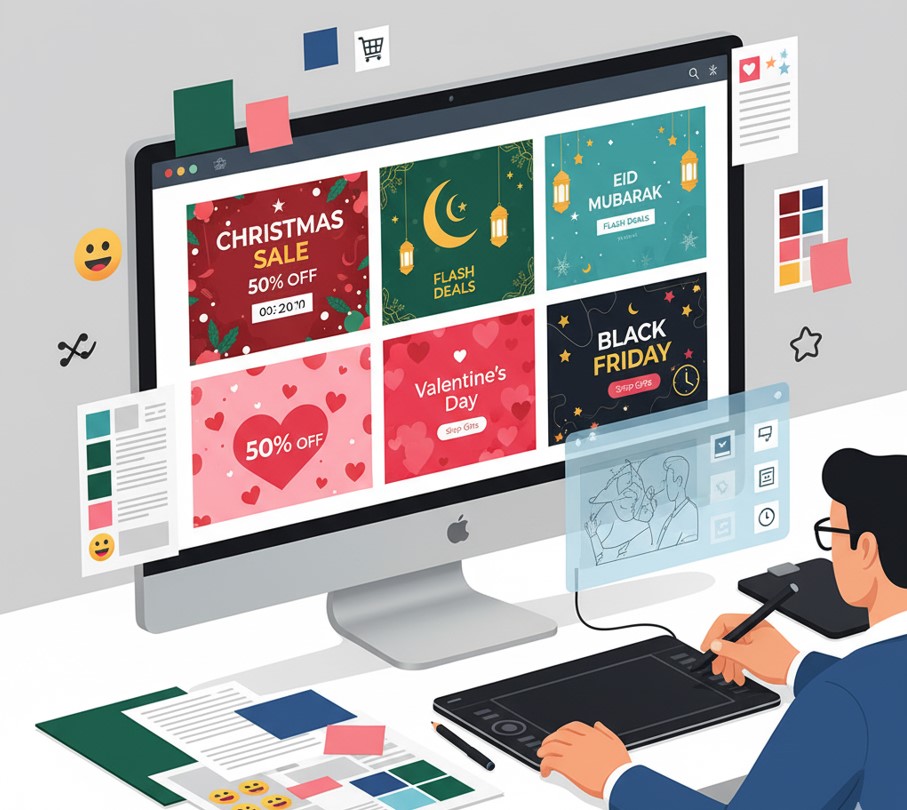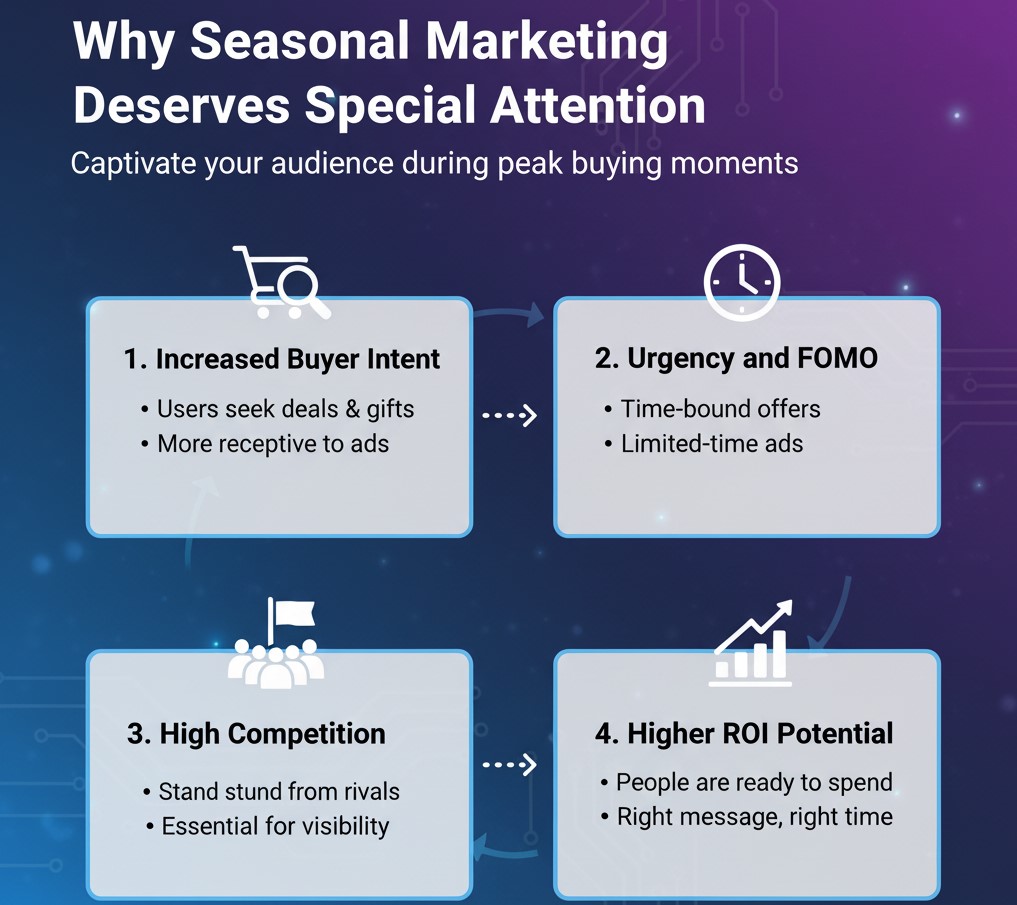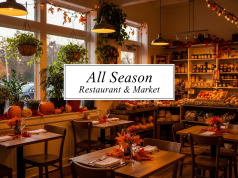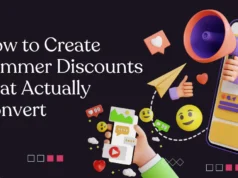Seasonal marketing is one of the most effective ways to drive engagement, conversions, and revenue—especially when paired with powerful advertising platforms like Facebook Ads and Google Ads. Whether it’s Black Friday, Christmas, Eid, Valentine’s Day, or Back-to-School, seasonal events offer businesses a golden opportunity to capture audience attention when buying intent is already high.
But going seasonal doesn’t mean just boosting any random post or running a basic search ad. It requires planning, creativity, data, and precise execution. In this blog, we’ll break down winning Facebook and Google Ads strategies you can use to maximize your seasonal marketing efforts.
Why Seasonal Marketing Deserves Special Attention
Before we dive into the tactics, let’s answer a simple question: Why focus on seasonal marketing at all?
1. Increased Buyer Intent
During festive seasons or promotional events, users are more likely to search for deals, discounts, and gift ideas—making them more receptive to ads.
2. Urgency and FOMO
Seasonal offers are time-bound, which creates urgency. You can capitalize on this with limited-time ads and countdowns.
3. High Competition
Your competitors are running campaigns too. Without a paid strategy, your brand might get lost in the crowd.
4. Higher ROI Potential
People are ready to spend—you just need to be in front of them at the right time with the right message.
Step-by-Step Strategy for Seasonal Facebook & Google Ads
Let’s break down a complete seasonal ad strategy, step by step, that works on both platforms.
Step 1: Plan Ahead Based on the Seasonal Calendar
Start by identifying relevant seasonal events for your niche or region. Examples include:
- Global: New Year, Valentine’s Day, Easter, Summer Sale, Halloween, Black Friday, Cyber Monday, Christmas
- Regional: Eid, Diwali, Chinese New Year, Thanksgiving
- Niche-Specific: Back to School, Wedding Season, Tax Season
Create a campaign calendar at least 2–3 months in advance. This gives you enough time to:
- Develop creatives
- Write ad copy
- Build landing pages
- Set up tracking
- Test your ads
Step 2: Define Campaign Goals
Decide what your seasonal campaign is meant to achieve:
- Brand awareness
- Lead generation
- Website traffic
- Direct sales
- App downloads
Your objective determines which ad types and bidding strategies you’ll use.
Example:
- For lead generation, use Facebook’s “Lead Ads” or Google’s “Lead Form Extensions.”
- For conversions, set up Google’s “Sales” campaign or Facebook’s “Conversions” campaign with Pixel tracking.
Step 3: Understand and Segment Your Audience
During seasonal campaigns, it’s crucial to target the right people. Some effective audience strategies include:
On Facebook:
- Custom Audiences: Retarget past buyers or site visitors.
- Lookalike Audiences: Target people similar to your existing customers.
- Interest Targeting: Focus on seasonal interests like “holiday shopping,” “travel deals,” or “gift ideas.”
On Google:
- In-Market Audiences: People actively searching for products/services in your category.
- Custom Intent Audiences: Based on keywords related to seasonal shopping.
- Remarketing Lists: Re-engage users who visited your site in the past.
Step 4: Craft Seasonal Ad Copy and Creatives
People don’t want generic ads during seasonal periods. You need to tap into the emotional triggers of the event—joy, urgency, gifting, family, gratitude, etc.

Best Practices:
- Use Seasonal Visuals: Update your images, videos, and banners with festive colors, symbols, or themes.
- Highlight Offers Clearly: “50% Off Christmas Sale” or “Eid Special: Buy 1 Get 1 Free.”
- Add a Countdown or End Date: Create urgency—“Offer Ends in 3 Days!”
- Consistent Branding: Make sure your seasonal theme is consistent across ads and landing pages.
- Use Regional Language: If your audience is location-specific, consider adapting your message.
- Leverage Emotion in Holiday Promotions: Highlight how your product or service makes the holidays more special—whether it’s solving a problem, saving time, or creating memorable experiences.
Step 5: Optimize Landing Pages for Seasonal Flow
Don’t run seasonal ads to your home page.
Instead, create dedicated landing pages or product collections that reflect the same seasonal theme and offer. Ensure:
- Mobile optimization
- Fast load speed
- Consistent messaging from ad to page
- Clear and persuasive call-to-action
Step 6: Set Up Smart Budgeting and Bidding
Expect higher CPCs during seasonal periods due to competition. However, smart budgeting can still yield a strong ROI.
On Google Ads:
- Use Enhanced CPC or Target ROAS if you have conversion data.
- Bid higher on high-performing keywords.
- Allocate more budget to high-intent audiences.
- On Facebook Ads:
- Use Campaign Budget Optimization (CBO) to auto-distribute budget across ad sets.
- Increase the budget gradually to avoid resetting the learning phase.
- Use lifetime budgets for short, time-sensitive campaigns instead of daily budgets.
Step 7: A/B Test and Monitor Performance
Even during short campaigns, test variables such as:
- Ad headlines
- Images vs. videos
- CTA buttons
- Offer types (20% off vs free shipping)
Track performance daily. Focus on:
- Click-Through Rate (CTR)
- Cost Per Click (CPC)
- Conversion Rate
- Return on Ad Spend (ROAS)
Pause underperforming ads and reallocate budget to high performers.
Step 8: Retargeting and Follow-Up Campaigns
Many users will click but not convert immediately. That’s where retargeting plays a key role.
Retargeting Ideas:
- Show ads to cart abandoners with an additional incentive.
- Display testimonials or customer reviews for social proof.
- Remind viewers of your earlier ads with a “Last Chance” message.
After the event, run follow-up campaigns such as:
- “Missed Our Sale? Here’s One Final Deal.”
- “End of Season Clearance – Everything Must Go.”
This helps you convert late decision-makers and clear remaining inventory.
Platform-Specific Tips
Facebook Ads Tips
- Use video creatives—they tend to outperform static images.
- Test Carousel Ads to showcase multiple seasonal products or offers.
- Use Facebook Pixel to track conversions and optimize for purchase behavior.
- Enable Automatic Placements to reach users across Facebook, Instagram, Messenger, and the Audience Network.
Google Ads Tips
- Use Search Ads for targeting high-intent seasonal keywords like “Christmas gifts under $50” or “Eid offers near me.”
- Launch Google Shopping Ads if you’re in e-commerce.
- Run Display Ads with festive visuals to raise awareness before peak buying days.
- Utilize Ad Extensions like sitelinks and countdown timers to improve ad visibility.
Mobile Optimization Matters
Most users browse Facebook and Google on mobile, especially during holidays when they’re shopping on the go. Ensure:
- Mobile-responsive ad creatives and landing pages
- Fast load times
- Tap-friendly buttons
- Simplified forms (especially for lead generation campaigns)
Common Mistakes to Avoid
- Starting Too Late: Seasonal campaigns need time for setup and testing.
- Generic Messaging: Use seasonal hooks and urgency-driven language.
- Not Retargeting: You’re leaving money on the table if you ignore warm leads.
- Neglecting Landing Pages: Poor post-click experience kills conversions.
- No Budget Flexibility: High-performing ads may need a sudden budget boost.
Final Thoughts
Seasonal offers and events are high-stakes, high-opportunity periods. Buyers are ready. The demand is there. But attention is limited—and competition is fierce. Your success will depend on how well you execute your strategy across platforms.
A well-planned Facebook and Google Ads campaign can make the difference between average performance and a record-breaking season. The key is to start early, know your audience, adapt your messaging, and optimize every step of the way.
Learn more about: How to Identify Market Demand Before Product Launch










